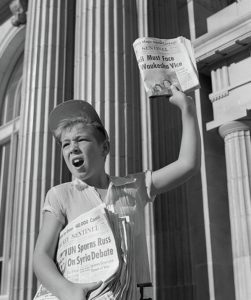When Ralph Harris, a 17-year-old Charlotte boy, told me that THE GAFFNEY STRANGLER had threatened his life –“Ralph Harris, I’m going to kill you.” — he laughed. Not a big laugh, but a laugh all the same. That was worrisome. Who laughs about someone threatening to kill them?
I was a reporter for The Charlotte News and I had been assigned to find Ralph Harris and write a story, on deadline, about what should have been a frightening phone call.
I asked him where he was when the strangler called and he said he was working at a mom and pop store he owned on Graham Street. And I said, “Ralph, you’re not but 17 years old.”
And he said, well, he and his father owned it. That was also worrisome.
I asked him what he was going to do when we finished talking and he said he was going to “hail a cab” and go home.
I knew Graham Street. My Dad owned a sweat shop on Graham Street, close to the stadium built years later for the Carolina Panthers football team. I had worked for my Dad in the summers when I was in junior high and high school — and I didn’t think Ralph Harris could have hailed a cab on Graham Street if he had stood on the curb all day.
Three red flags.
I knew that boy wasn’t telling the truth. But I also knew it was 12:15 p.m. and deadline was only 15 minutes away. Besides, what did it matter what I thought I knew? The truth was never going to come out.
Only two people knew for sure what had or hadn’t happened and neither one of them were ever going to say. THE GAFFNEY STRANGLER knew, but he wasn’t going to say. And the boy knew, but he wasn’t going to say either. If he admitted he had lied he could be charged with making a false police report.
So I began to write:
“‘Ralph Harris, I’m going to kill you.'”
“That’s what THE GAFFNEY STRANGLER told a 17-year-old Charlotte boy …”
Bla, bla, bla.
I met deadline, accepted pats on the back for a job well done, and went to lunch with Darrell Sifford, the managing editor.

As we walked back to the office I heard a paperboy on the corner of Trade and Stonewall Streets, next to our building, hawking my story to passersby. In a singsong chant he shouted: “Gaffney Strangler Threatens Charlotte Boy! Read all about it!”
They don’t hawk papers on the street anymore, haven’t for decades. I loved hearing paperboys shouting the news of the day, especially when they were shouting about a story I had written.
Anyway, the M.E. and I turned in the front door of the building, crossed the little lobby in two steps, and pushed the elevator button. The door opened and a couple of our reporters got off. One of ’em said, “Did you hear the latest on THE GAFFNEY STRANGLER story?
I wanted to say, “Hear it? My dear boy, I wrote it.” But I restrained myself. Instead, I said, “No, what happened?”
And he said, “The boy took it all back.”
“What!” I said.
“The boy took it all back,” he repeated.
I asked what had happened.
He said the TV reporters found Ralph Harris after I had filed my story and were interviewing him when his Dad walked in, saw the cameras, and asked, “What’s going on?”
A TV guy said, “Haven’t you heard? Your boy has been threatened by THE GAFFNEY STRANGLER.”
And his Dad said, “My boy is psycho.”
And the boy said, “That’s right. I’m psycho.”
After that I gave some thought to calling that boy myself and saying, “Ralph Harris, I’m going to kill you.”
Postscript: THE GAFFNEY STRANGLER was captured days later, tried, convicted and given four life sentences. He was stabbed to death in prison in 1972.
NOTE: That was the last quote lead I ever wrote. Ralph Harris cured me. He also changed the way I reported. From that story on, if I thought someone had lied to me I tried my best to prove it.
Coming Monday: “Good Luck”
